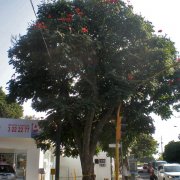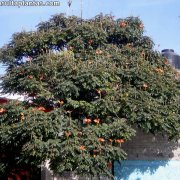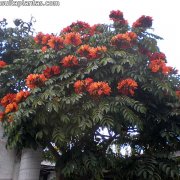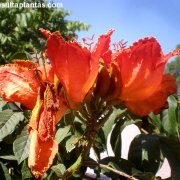Care of the tree Spathodea campanulata or African tulip tree |
|
The genus Spathodea, family Bignoniaceae, includes a single species of tropical tree native to Africa: Spathodea campanulata. Common names: African tulip tree, Fountain tree, Pichkari, Nandi flame. This species is native to tropical Africa. They are evergreen trees with an elegant bearing and a wide crown (10 meters/32.8 feet in diameter) that reach 25 meters (82 feet) in height. The leaves are pinnately compound, 70 cm (2.29 feet) long, and have 15 dark green elliptical leaflets. The large and abundant orange flowers appear in terminal racemes. They usually bloom in spring but can do so in other seasons. The fruits are pod-shaped. African tulip tree is used as shade trees in large gardens and in public streets and parks for its attractive flowering and elegant bearing. It's a fast growing plant ideal for regions with a tropical or subtropical climate. In Mexico many specimens are seen on the streets and in private gardens. Spathodea campanulata needs a sunny exposure and high temperatures; if it's cold (less than 8 ºC/46.4 ºF) they can lose the leaves. It does not resist frost. The soil must have little lime, be light and contain organic matter; Fountain tree can grow in poor soils. Water frequently so that the soil does not dry out completely; Nandi flame resists several days of drought. African tulip tree does not need pruning. Fertilize in autumn with manure. Spathodea campanulata is a tree resistant to the usual pests and diseases. Fountain tree is propagated from seeds (they germinate easily), by cuttings or from root shoots. In tropical climates it can become invasive plant. |
Images of the tree Spathodea campanulata or African tulip tree |
Find plants
Spathodea campanulata or African tulip tree | Care and Growing
© 2025 FavThemes




